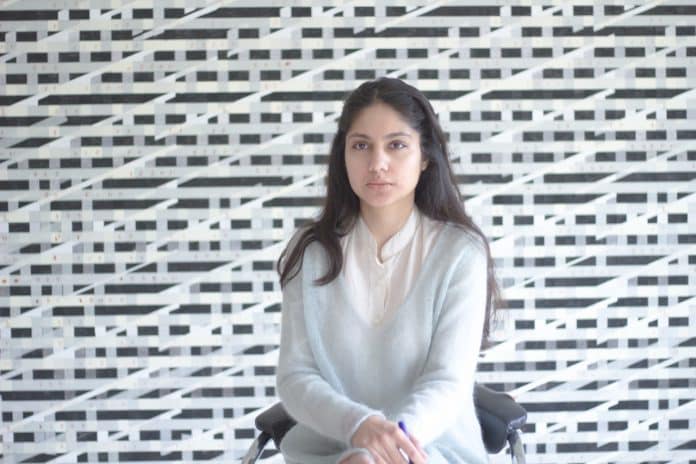There is a fine, meditative quality to Tanya Goel’s creations being displayed at Artspace in Sydney as part of the ongoing Sydney Biennale. They convey precision even when exploring the rubble and roughness of urban cityscapes. Index: pages (builders drawing), 2018, a reconstructed wall drawing, is a measure of the water level which took three weeks to create. Constructed using the archaic method of dipping a thread in builders’ blue chalk and drafting snap lines across a surface to establish a level. The process is performative and repetitive and what is we see is the residue of the process. “Three people need to orchestrate their movements and coordinate so each line is formed at sea level,” the artist explains.

Tanya’s method lies in her quest for going beyond the visible to find connection between colour and substance. “I’m interested in understanding the different layers that form a city: the surface, material, properties and the chemistry of all things. I’d call my practice alchemical.” She gathers materials like charcoal, aluminium, concrete, glass, soil, mica, graphite and foils from architectural ruins of structures, some built between the ‘50s and the ‘70s, to convert them into pigments for use in her own works.
Canvases Carbon, (extension lines), 2018, and Carbon, (frequencies on x, y axis), 2018, inhabit her pigments made from coal, aluminium, concrete and mica in combination with oil paint. Ditto Fresco on cement and stone, 2017, plaster and graphite on found debris from houses. “The paintings are archives of dust and directly refer to a period of modern architecture in India. These forms of government architecture reflected socialist agendas and futuristic visions of a newly independent nation. In demolition of these sites, I see failure of modernity,” says Tanya.

As a child, she was obsessed with discarded colours from textiles manufactured by her parents. The inability to hold colour and the failure to categorise it, is what draws Tanya to it. “I’m very interested in how colour creates moments of fiction, distraction in our everyday lives. The effect of colour on how we perceive the world around us has always fascinated me.”
Study stints in various cities like Baroda, Chicago and Brooklyn, before returning home to Delhi, also helped shape and impact her work. “Chicago is the epitome of modern architecture and bears heavily on how our bodies and movements are shaped by the grid. I felt it restrictive and the movement of wandering, constrained. Baroda at the time was still quite organic in parts, awaiting full-swing capitalisation to take hold,” she recalls.

She continues to create and critically comment on unequal social matters. “The change and influx are associated with an increase in unfamiliarity. It leads to the phenomenon of post-modern homelessness.”
Read our coverage of NS Harsha’s artwork at Sydney Biennale.
Sydney Biennale: Seeking perfection in the rubble
Delhi artist Tanya Goel’s works at the Sydney Biennale are a psychosocial comment on the nature and effect of urban landscapes. By HAMIDA PARKAR

Reading Time: 3 minutes



